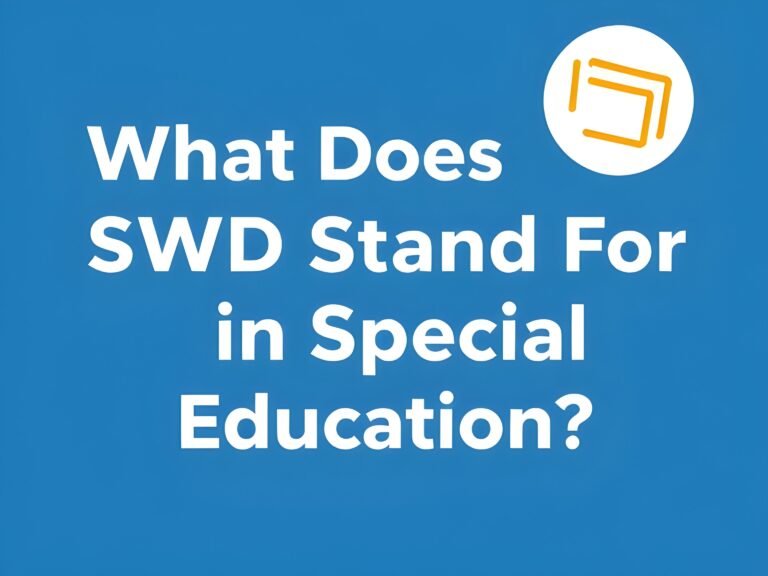Special education serves millions of students across the United States, but many parents, educators, and community members encounter unfamiliar acronyms that can be overwhelming. One term frequently found in educational documents, meetings, and discussions is “SWD.” Understanding this acronym is crucial for anyone involved in supporting students who require specialized educational services.
This article will explain what SWD means in special education, explore the characteristics of these students, and discuss why understanding this terminology matters for creating inclusive learning environments.
Table of Contents
What SWD Stands For
In special education, SWD stands for Students With Disabilities. This term refers to students who need specialized instruction and support to access education due to a diagnosed disability.
The acronym SWD is widely used in educational settings, including:
- IndividualizedIndividualized Education Programs (IEPs)
- 504 plans
- Educational research and data collection
- Policy documents and legislation
- Teacher training materials
- Parent-teacher communications
Educational professionals use this term to ensure clear communication when discussing services, accommodations, and support strategies for students who require specialized specialized assistance.
Understanding Students With Disabilities
Types of Disabilities in Educational Settings
Students with disabilities represent a diverse group with varying needs and abilities. The Individuals with Disabilities Education Act (IDEA) recognizes 13 specific disability categories that qualify students for special education services:
Intellectual and Developmental Disabilities:
- Intellectual disability affects cognitive functioning and adaptive behaviour
- Autism spectrum disorder impacts social communication and behaviour
- Multiple disabilities involve combinations of impairments
Physical and Sensory Disabilities:
- Visual impairments, including blindness
- Hearing impairments, including deafness
- Orthopaedic impairments affecting movement or motor skills
- Other health impairments like ADHD, epilepsy, or chronic conditions
Communication and Learning Disabilities:
- Speech or language impairments
- Specific learning disabilities affecting reading, writing, or math
- Deaf-blindness combining hearing and visual impairments
Behavioural and Emotional Disabilities:
- Emotional disturbance affecting educational performance
- Traumatic brain injury resulting from external force
Educational Needs and Support Services
Students with disabilities require individualized, individualized learning approaches tailored to their specific needs. Their educational needs may include:
Instructional Modifications:
- Adapted curriculum materials
- Alternative teaching methods
- Assistive technology tools
- Modified assignments and assessments
Environmental Accommodations:
- Reduced distractions in learning spaces
- SpecializedSpecialized seating arrangements
- Additional time for completing tasks
- Access to quiet testing environments
Support Services:
- Speech and language therapy
- Occupational therapy
- Physical therapy
- Counselling services
- Behavioural support plans
Why Understanding SWD Matters
For Educators
Teachers and school staff benefit from understanding SWD terminology because it helps them:
- Communicate effectively with special education teams
- RecognizeRecognize when students may need additional support
- Implement appropriate accommodations and modifications
- Collaborate with parents and specialists
- Document student progress accurately
For Parents and Families
Parents of students with disabilities need to understand this terminology to:
- Advocate effectively for their children
- Participate meaningfully in IEP meetings
- Understand educational documents and reports
- Communicate with school personnel
- Access appropriate resources and services
For the School Community
When entire school communities understand SWD terminology, it promotes:
- Inclusive attitudes toward all students
- Better support for classroom teachers
- Improved collaboration between general and special education
- Enhanced awareness of disability rights and services
Legal Framework and Rights
The term SWD is closely connected to crucial federal legislation that protects students with disabilities:
Individuals with Disabilities Education Act (IDEA)
IDEA ensures that students with disabilities receive free appropriate public education (FAPE) in the least restrictive environment (LRE). This law requires schools to:
- Identify students who may need special education services
- Conduct comprehensive evaluations
- Develop individualized, individualized education programs
- Provide necessary related services
- Include parents in educational decisions
Section 504 of the Rehabilitation Act
Section 504 protects students with disabilities from discrimination and ensures equal access to education. Students who don’t qualify for services under IDEA may still receive accommodations under Section 504.
Creating Inclusive Environments
Understanding what SWD stands for in special education is just the beginning. Creating truly inclusive environments requires:
Professional Development
Educators need ongoing training to:
- Understand various disability types
- Learn evidence-based teaching strategies
- Develop cultural competence
- Practice collaborative approaches
Family Engagement
Schools must actively involve families by:
- Providing information in accessible formats
- Offering translation services when needed
- Scheduling meetings at convenient times
- Respecting family perspectives and values
Peer Support
Students benefit when schools promote the following:
- Disability awareness programs
- Peer mentoring opportunities
- Inclusive extracurricular activities
- Anti-bullying initiatives
Frequently Asked Questions
What percentage of students are classified as SWD?
According to the National Center for Education Statistics, approximately 14% of public school students receive special education services under IDEA.
How are students identified as SWD?
Students are identified through a comprehensive evaluation process that includes referrals, assessments, and team meetings with parents, teachers, and specialists.
Can a student be removed from the SWD classification?
Yes, students can be declassified if they no longer need special education services. This decision requires careful evaluation and team consensus.
Does SWD always need separate classrooms?
No, most students with disabilities are educated in general education classrooms with appropriate support and accommodations.
What happens to SWD after high school?
Students with disabilities have various post-secondary options, including attending college, pursuing vocational training, securing employment, and engaging in independent living with appropriate support.
Are there different types of SWD classifications?
Yes, students may receive services under different categories based on their primary disability. However, the support is individualized, individualized regardless of the classification.
Supporting Students With Disabilities Successfully
Understanding what SWD stands for in special education opens the door to creating more inclusive and supportive learning environments. Students with disabilities have the same right to quality education as their peers, and with proper support, they can achieve significant academic and personal success.
Every student with a disability brings unique strengths, perspectives, and potential to the classroom. When educators, families, and communities work together to understand terminology and best practices, students with disabilities can thrive academically, socially, and emotionally.
The journey toward inclusive education requires commitment, resources, and ongoing learning. By understanding fundamental terms like SWD and the comprehensive support systems they represent, we can build educational environments where all students can reach their full potential.


